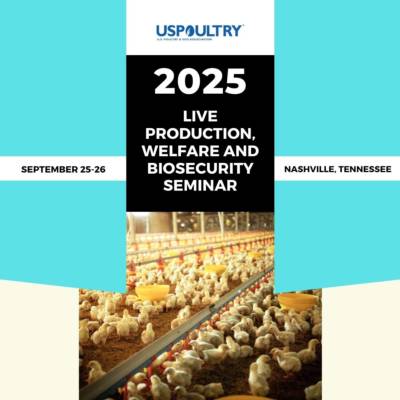- FOUNDATION
- |
- IPPE
- |
- PPFC
- |
- CONTACT
News Release
- Media Center Home /
- News Release View


For Immediate Release
U.S. Poultry & Egg Association
Tucker, Ga. - August 7, 2025
- Contact:
- Hannah Keck, 678.514.1979, hkeck@uspoultry.org, (USPOULTRY)
Researchers Seek to Understand How Enterococcus cecorum Has Adapted in Chickens
USPOULTRY and the USPOULTRY Foundation announce the completion of a research project focused on how Enterococcus cecorum (E. cecorum) has adapted in chickens, showing characteristics of antibiotic resistance. The research is part of the Association’s comprehensive research program encompassing all phases of poultry and egg production and processing and is made possible in part through proceeds from the International Poultry Expo, part of the International Production & Processing Expo.
Project #F109: Control of Enterococcus cecorum Through Identifying Its Dynamics of Adaptation to the Chickens and Its Environment
(Dr. Martha Pulido-Landinez, College of Veterinary Medicine, Mississippi Veterinary Research and Diagnostic Lab, Mississippi State University, Pearl, Miss.)
Dr. Pulido-Landinez, associate clinical professor at Mississippi State University, and other research colleagues conducted a study to recognize the dynamics of E. cecorum in vertical integrations by identifying and characterizing isolates recovered from breeders, hatcheries and broilers. Findings indicated that an emerging pathogenic strain of E. cecorum is responsible for severe systemic disease in broilers. The age-specific presence of Enterococcus faecalis (E. faecalis) and E. cecorum suggests that early detection of E. faecalis may be a warning sign for later E. cecorum infection. This allows timely interventions to prevent costly losses when the chickens get older and heavier and, therefore, gain value. The long survival time of pathogenic E. cecorum, especially in litter, underscores its role in recurring disease and the need for long-term control measures. While tested disinfectants are effective against E. cecorum in its naked form, organic matter reduces their effectiveness. Sanitation protocols must account for strain type, disinfectant choice and organic load.
The research summary can be found on the USPOULTRY website. Information on other Association research may also be obtained by visiting the USPOULTRY website, uspoultry.org.
###
More Recent News
August 6, 2025
Largest Trade Show Floor Ever for the 2026 IPPE!
The 2026 International Production & Processing Expo (IPPE) is less than six months away and has surpassed 629,000 square feet of exhibit space and secured more than 1,130 exhibitors. It is the...

August 5, 2025
USPOULTRY Offers Practical Biosecurity Resources for Commercial Poultry Producers Training
Biosecurity is the first line of defense in poultry production. It protects bird health, farm profitability, human safety and global food systems. In a world where disease threats are rising, it...
July 31, 2025
2025 USPOULTRY Live Production, Welfare and Biosecurity Seminar to Tackle Key Challenges in Live Production
The 2025 USPOULTRY Live Production, Welfare and Biosecurity Seminar will equip poultry professionals with practical tools and insights to address production efficiencies, welfare and bios...

General Info
Events & Meetings
People & Groups
- Affiliated States
- Air Cargo Committee
- Hen Council
- Industry Partners
- Poultry Protein & Fat Council
- USPOULTRY Foundation
